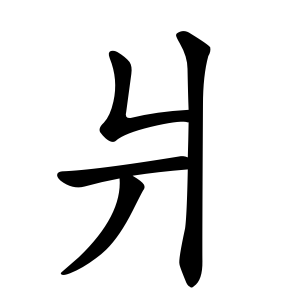爿
- a piece of split wood;
The left half of a piece of wood that has been split vertically into two parts.
Etymology
Based on its oracle bone script form, it is believed to depict a bed frame standing upright, so its original meaning was "bed." The meaning of "wooden piece" or "plank" is thought to have developed later.
It is a mirror image of the character 片.
Usage in Korean
When used as a radical, it appears on the left side of characters like 將 (general), which is why it's sometimes informally called the "jangsu-jang-byeon-bu" (general-left radical). However, 將 is actually classified under the 寸 (chun, "inch") radical, not 爿.
It also resembles the character ‘뉘’ (a Korean syllable), which may cause visual confusion.
Alternative forms
In Japanese shinjitai and Simplified Chinese, 爿 has been simplified to 丬
Characters with 爿
17 strokes
爿
나뭇조각
장
namutjogak
jang
Kangxi radical:90
Strokes:4
Unicode:U+723F
Cangjie input:
- 女中一 (VLM)
Composition:
- ⿰⿱ 𠃊 丆 丨
